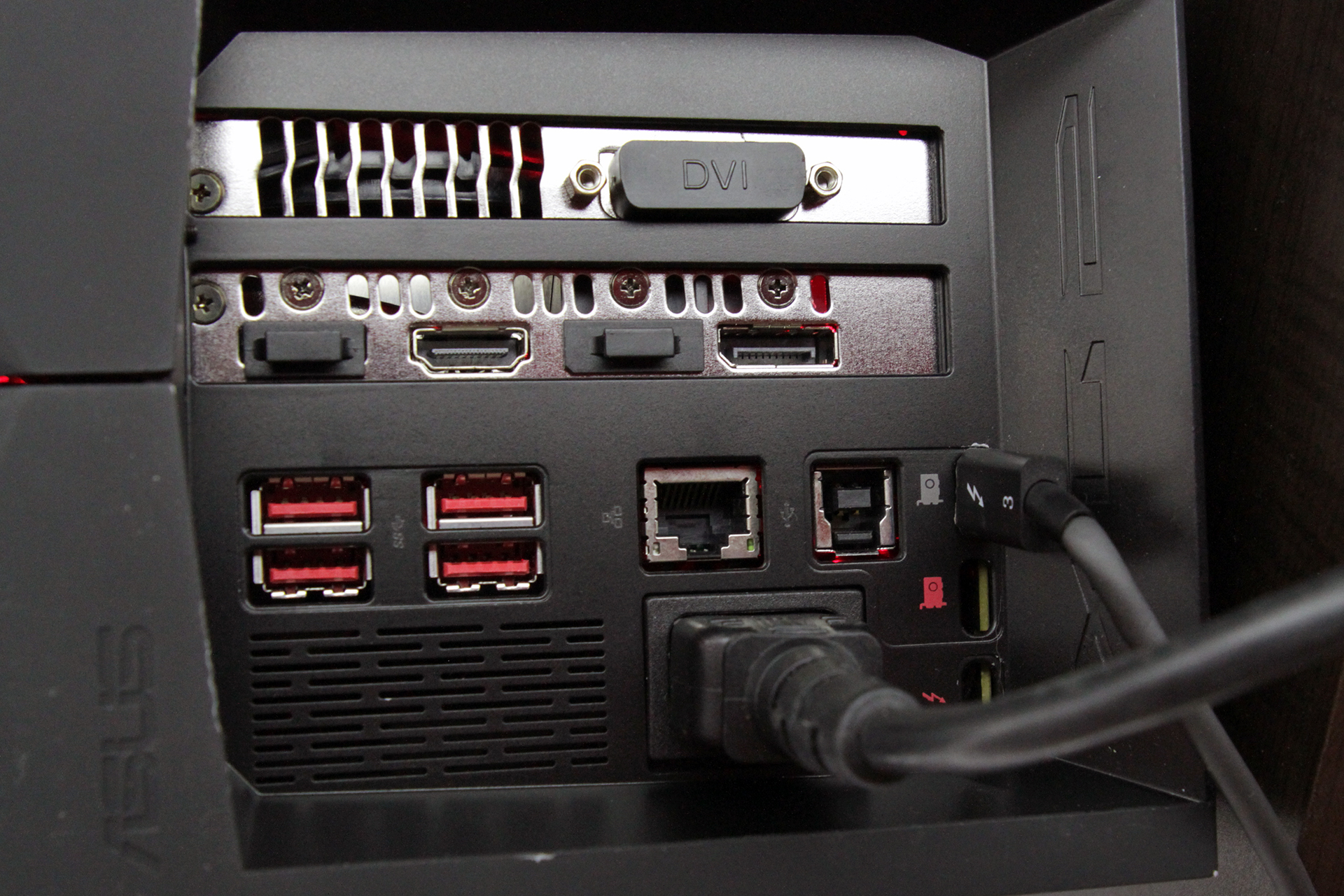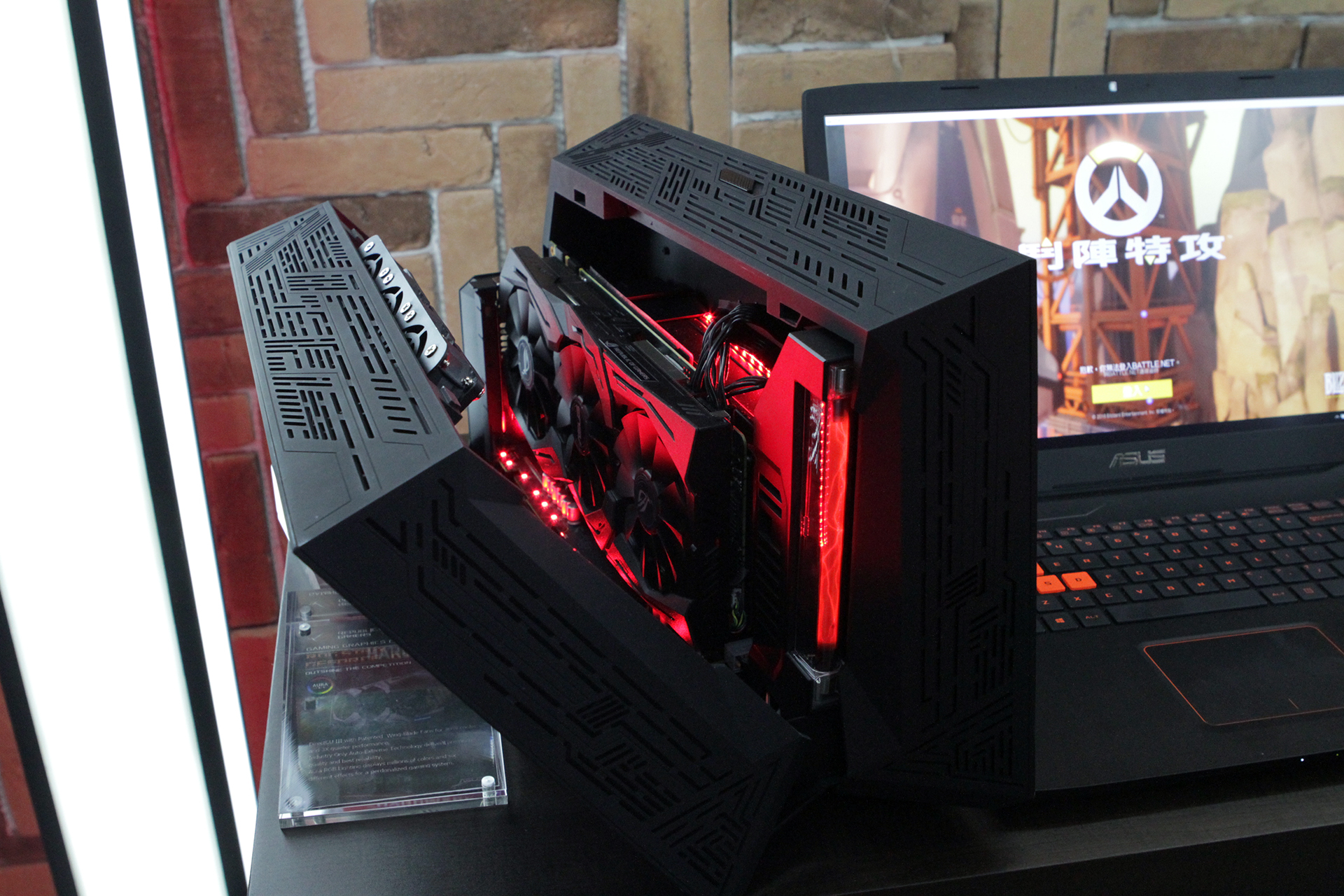Asus Bows To Compatibility, Adds USB Type-C To External GPU Dock
Asus didn’t have many ROG announcements at Computex 2016, and the few it did have were mostly lost at its loud, dark, 3D laser-lightshow-like press conference. But when we had a chance to walk through the company’s booth later in the week and pepper each project manager in turn, we found that Asus’ external graphics dock has received some updates, most notably a USB Type-C port.


Bowing To Compatibility
At CES time this past January, the external graphics docks from major companies were sorted into two camps: those that used a proprietary connector for the PC and those that relied on a standard connector (Thunderbolt 3 over USB Type-C).
The sticking point--at least to hear the companies say it--is bandwidth. Although on paper Thunderbolt 3 is 40 Gbps, it loses some of its total bandwidth to encoding overhead, so the actual bandwidth is closer to 32 Gbps.
In order to get the full 40 Gbps of bandwidth (and possibly for other reasons), both Asus and MSI relied on proprietary PCIe connectors. The downside there is of course compatibility; that dock can work with only a laptop with that special connectivity. Further, Asus’ XG Station 2 had two cables, which is just clunky. By contrast, Thunderbolt 3 is a one-cable solution and an open standard, so any system with the right USB Type-C port could make use of a thus-equipped GPU dock.
Razer took the USB Type-C approach with its Razer Core dock, for the reasons mentioned above, and we suspect that HP (and other companies) might be cooking up their own versions, too. Powercolor, for instance, has its Devil Box GPU dock prototype just about ready to go.
Once Razer announced the Core, Asus had two choices: It could double down on its proprietary connector or it could sheepishly revert to USB Type-C. It did neither. Instead, the company added a USB Type-C port to the XG2 and also kept its proprietary PCIe connector. (Let that be a lesson in false dichotomies, kids.)
Simply, this allows Asus to test the market without risk. If the product team finds that consumers are buying the XG Station 2 and pairing it mainly with Asus laptops, then maybe they nix that USB Type-C port. If the dock sells well as a standalone unit, that would tell them that the Type-C port should stay.
Get Tom's Hardware's best news and in-depth reviews, straight to your inbox.
The XG Station 2 will come to market later this year, and when it does, it will have both ports.
You Got The Power
In addition to all the port drama, we learned more about the XG Station 2’s power supply. It’s a 680W PSU, and Asus broke it down for us: 500W is allotted for the graphics card, 80W is for the Quick Charge function and any connected accessories, and 100W is set aside for power delivery over the USB Type-C port. (That means you can connect a laptop to the XG Station 2, and the dock will charge the laptop.)
That leaves plenty of headroom on this PSU, and partially, that’s because Asus anticipates people overclocking the cards, and it allows for dual GPUs to be used in the XG station 2, which is something Asus is considering.
Asus also told us that there will be an Asus ROG laptop coming that will be equipped with its two-cable proprietary connector. We presume that as-yet unnamed laptop will launch alongside the XG Station 2 in Q4 2016.
Seth Colaner is the News Director for Tom's Hardware. Follow him on Twitter @SethColaner. Follow us on Facebook, Google+, RSS, Twitter and YouTube.
Seth Colaner previously served as News Director at Tom's Hardware. He covered technology news, focusing on keyboards, virtual reality, and wearables.
-
kinney All this tells me is avoid Asus products. If they can, they're going to lock me in. Rather find someone else to give money to.Reply -
Xenocrates ReplyAll this tells me is avoid Asus products. If they can, they're going to lock me in. Rather find someone else to give money to.
Right. That they are continuing to have it be compatible with their previous offerings, while also making it compatible with anything else on the market is a sign of lock in, not them attempting to avoid screwing any customers.
I must admit, I am a bit of an ASUS fanboy though. I have my motherboard and laptop both from them, and look to them as to where the market will likely go. After all, they pushed M.2, U2., and started the real push for LED lighting. Not to mention that they were some of the first to ship USB 3.1 with motherboards (Admittedly on a PCIE card). So full disclosure: I like what they do and give them plenty of money. But I think this is trying to push the envelope while making it work for the majority of users, not a step towards lock in. -
SirKnobsworth Thunderbolt 3 can support 40 Gbps in each direction, but you're limited to 32 Gbps because that is the max speed of the PCIe 3.0 x4 interface that connects it to the host.Reply -
hpram99 ReplyIf its proprietary we don't want it, manufacturers need to get the hint
Apple would beg to differ. -
liljohnny This needs to wrok at least with current ASUS models over Thunderbolt 3. Even if it takes using two cables and stealing some bandwidth elsewhere. A lot of folks just spent a ton of cash on high end ROG G752 machines and wont just toss a new machine. Id buy a desktop before I went there. Adding to that the fact that one can but the Razor that works over thunderbolt 3 and you see why ASUS reconsidered and added the Type C Thunderbolt connection. I would rather the ASUS but if its not compatible whats the point?Reply


